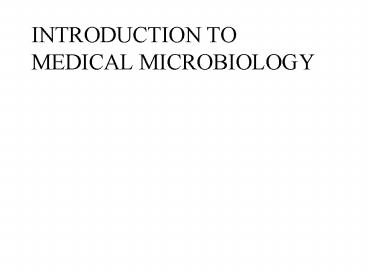INTRODUCTION TO MEDICAL MICROBIOLOGY - PowerPoint PPT Presentation
1 / 13
Title:
INTRODUCTION TO MEDICAL MICROBIOLOGY
Description:
... TO MEDICAL MICROBIOLOGY. What is microbiology? Bacteriology. Virology. Mycology. Immunology. Genetics. Historical Perspective: Hooke 1665- cells in cork ... – PowerPoint PPT presentation
Number of Views:96
Avg rating:3.0/5.0
Title: INTRODUCTION TO MEDICAL MICROBIOLOGY
1
INTRODUCTION TO MEDICAL MICROBIOLOGY
2
What is microbiology?
- Bacteriology
- Virology
- Mycology
- Immunology
- Genetics
3
Historical Perspective
- Hooke 1665- cells in cork
- Edward Jenner 1796- First successful
vaccination. - Smallpox (virus)
- 30-40 mortality
- Viremia followed by death
- Last naturally occurring case in Africa, 1976.
- Role of WHO in smallpox eradication
- Possible because humans are the only smallpox
host. - So, where are we now?
- Who is immune?
- Possibility of bioterrorism.
- Todays plan Immunize first responders, then
public.
4
SMALLPOX RASH DISTRIBUTION
5
Schwann 1839- The Cell Theory
- All organisms are made up of cells
- The cell is the basic organizational unit of life
- Cells cannot arise de novo.
6
Snow 1853 First successful epidemiological
study.
- Culprit Vibrio cholerae, contaminating a water
pump on Broad Street in London. Actual raw
sewage into drinking water. Closed down the pump
epidemic over. - Cholera still responsible for tens of thousands
of deaths a year. - Van Leeuwenhoek 1674. Optician, first
microscope. Bacteria viewed Bacillus anthracis.
7
Louis Pasteur
- Redi 1800. Disproved theory of spontaneous
generation which said that living organisms can
arise from dead matter, e.g. maggots on dead
horseflesh. Said maggots came from eggs of
flies, not meat. Still, no one believed him. - Pasteur 1861. Figure 1.2. Basically, air
contains microorganisms. Made sterile solutions
by using cotton plugs. Plug captures bacteria
and can then be used to inoculate sterile
infusions. - Also used a swan flask to disprove the vital
force theory that the infusions themselves had
the ability to capture the bacteria. - 1864 -Pasteurization of wine
- Immunoprophylaxis for rabies
- Described fermentation pathway of sugar to
ethanol and carbon dioxide in an anaerobic
environment.
8
Lister 1867 Study of childbed fever in a
London lying-in hospital.
- Aseptic technique
9
Koch 1876- Linked anthrax to a bacterium
- Kochs Postulates
- Microorganism must be present in every case of
the disease - Organism must be grown in pure culture from the
diseased host - Inoculation of above into host must give same
disease - Organism must be recovered from experimentally
infected host - Also presented methods of obtaining pure cultures
- Gram Stain 1884
- 1892 - Filterable agent in tobacco mosaic disease
a virus
10
- 1911 Rous sarcoma virus (a retrovirus) can
cause cancer in chickens. - Other virus/cancer links
- HIV _ Kaposis sarcoma
- HPV Cervical cancer
- Hepatitis B- Liver cancer
11
Griffith 1928 The Transforming Principle (p.
206)
- Experiment to determine which part of a
pneumococcus bacteria caused the disease. - 1944 Its the DNA, not the capsule, not the
cytoplasm. Provided the groundwork for Avery and
McLeods definitive work, as well as for Watson
and Crick
12
Fleming 1929 Penicillin
13
1953 Watson, Crick, Franklin, and Wilkins
- The structure of DNA
- 4 nucleotides 2 purines (A and G) and 2
pyrimidines (C and T). - Name origin (tissue each base was isolated from)
- Adenine from pancreas
- Guanine from bird guano
- Thymine from thymus gland
- Cytosine from cells
- Base covalently bonded to 5 carbon sugar
molecule, which is then bonded to a phosphate
molecule































